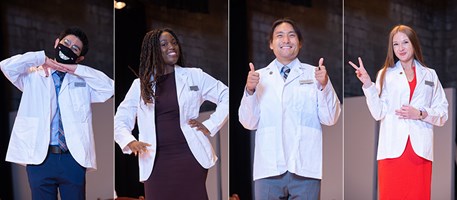White Coat Ceremony Welcomes New Med Students to SMD
White Coat Ceremony Welcomes New Med Students to SMD
Last week, in a ceremony like none before, the School of Medicine and Dentistry inducted 104 medical students, a rite of passage in their journey into medicine, during the annual Robert L. & Lillian H. Brent White Coat Ceremony.
Classmates applauded and cheered as students proudly donned their coveted white coats for the first time.
Like so many activities altered by pandemic guidelines, the Aug. 14 ceremony was held privately at the Larry and Cindy Bloch Alumni and Advancement Center to accommodate social distancing.
Here are a few facts about members of the Class of 2024:
They are global: There were nearly 5,600 applicants who wanted to be a part of this class and only 1.8 percent are enrolled today. There are 56 women and 48 men, and 57 are persons of color – a 32 percent increase over last year. Students came from 29 different states and China, Korea, Canada, France, Ghana, Israel, India, Pakistan, New Zealand, Norway, Philippines, Poland, Trinidad & Tobago, Vietnam, Russia and Ukraine.
And they are fluent in Spanish, French, Italian, Urdu, Hindi, Russian, Arabic, Mandarin, Tui, German, Greek, Hebrew, Japanese, Korean, Malayalam, Persian, Portuguese, Punjabi, Tagalog, Hungarian, Polish, Vietnamese and American Sign Language.
They’re the cream of the crop: Most graduated with honors, including summa and magna cum laude, and one student is a National Institutes of Health Gates-Cambridge Scholar.
And they came to us from 59 different colleges and institutions, including 19 University of Rochester graduates. They’ve earned undergraduate degrees in more than 24 different majors, from biology and neuroscience, to journalism and theater arts. Several have earned master’s degrees and two have already completed doctoral degrees in physical therapy and law.
They prioritize volunteerism: Every member of the class has dedicated time to volunteering for outreach programs, alternative summer breaks, health care brigades, and other college or religious-sponsored organizations.
They’ve served with AmeriCorps, Teach for America, and as Fogarty awardees. Students have rolled up their sleeves to provide support and learn all over the world – from India to Sierra Leone, Peru to Copenhagen and Beijing to Guatemala. One student even delivered water, by backpack, through the desert to save the lives of hopeful immigrants.
They work hard: Students demonstrated their commitment to helping others by working in legal aid and urban HIV clinics, creating business models to clothe the homeless, becoming slam poets, and writing books supporting religious and ethnic minorities.
The class has enough trained EMTs to staff a full squad for pre-hospital care. Others worked as audio engineers, IT systems managers, architects, lawyers, fashion writers, investment bankers, EPIC software designers, full-time musicians, physical therapists, baristas, office workers, research coordinators, food service workers and nannies.
They get moving: There are athletes and artists who performed on the field and stage. They competed in collegiate or club baseball, basketball, soccer, lacrosse, swimming, diving, water polo, tennis, hockey, sailing, skiing, martial arts, running, marathons and triathlons, Gaelic football and rock climbing. And there’s a surprisingly large number of wrestlers and fencers, which could make for interesting negotiation or conflict resolution.
And if there’s music, students may show off their hip hop, swing, and Bhangra skills.
They are leaders: They are advocates against racism, sexism, misogyny, xenophobia, ableism and ageism. Students have served as community organizers, in political endeavors, and on committees to combat intimate partner violence, rape, suicide prevention, deportation and bias against LGBTQ populations.

